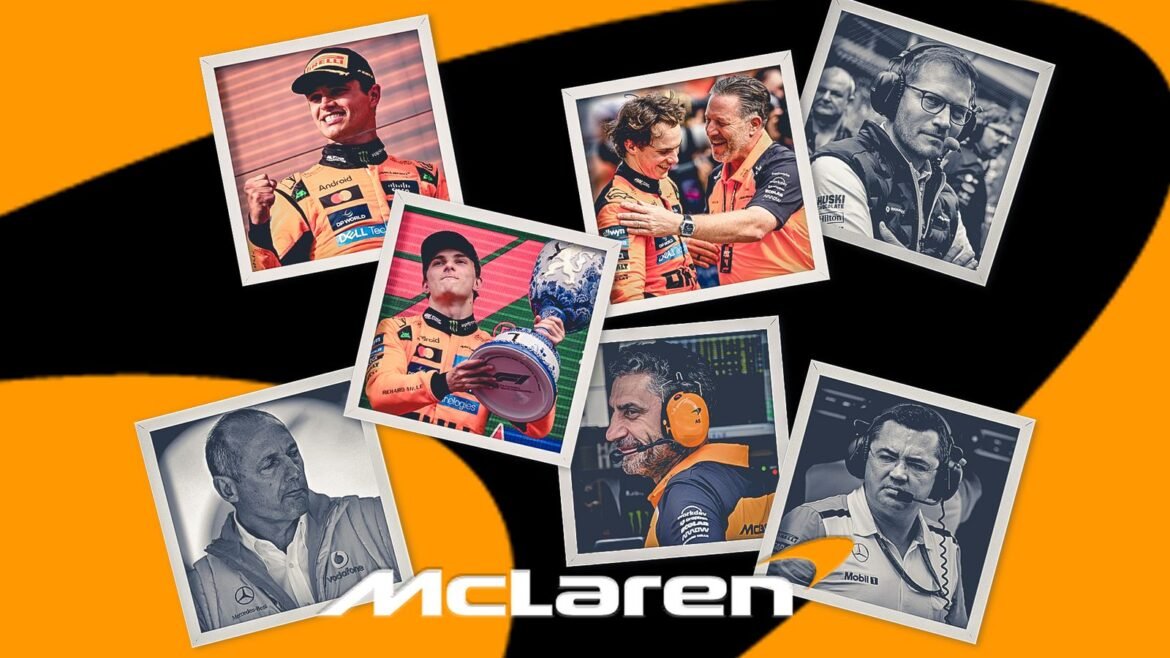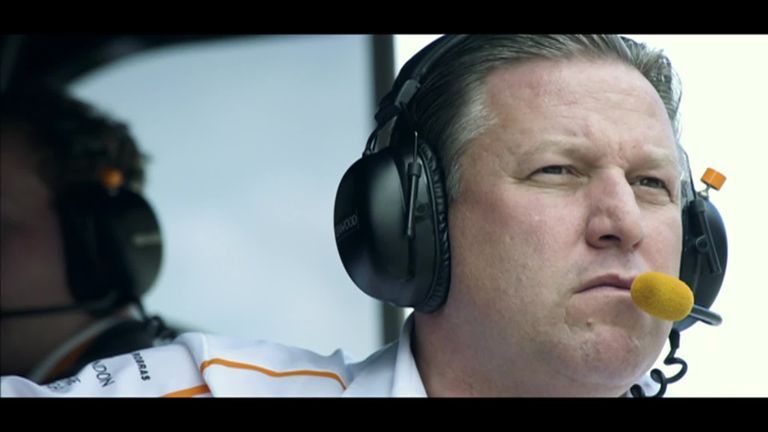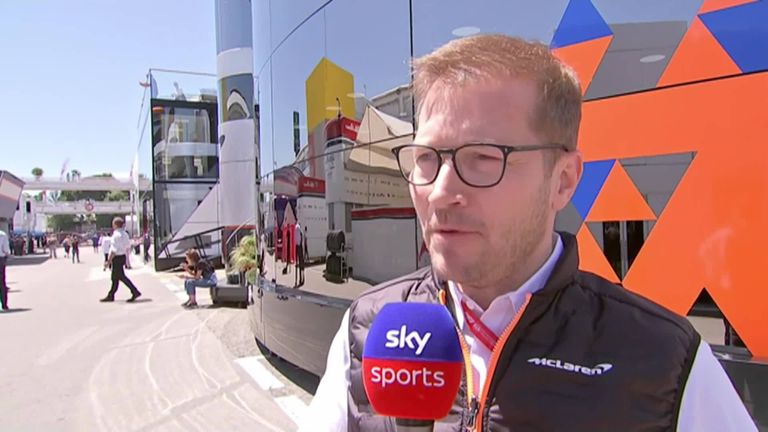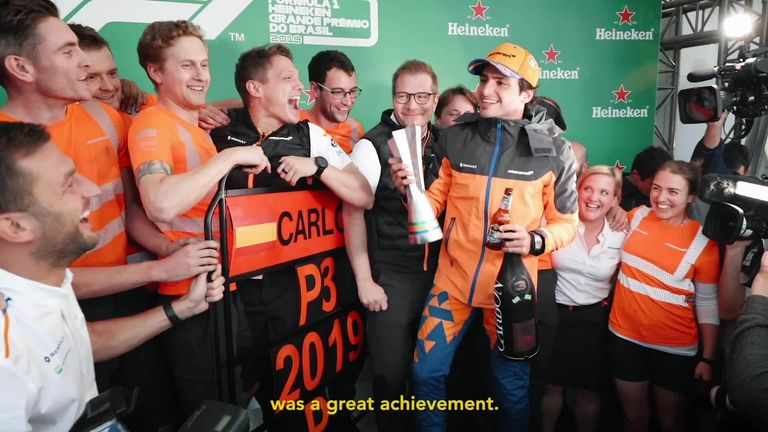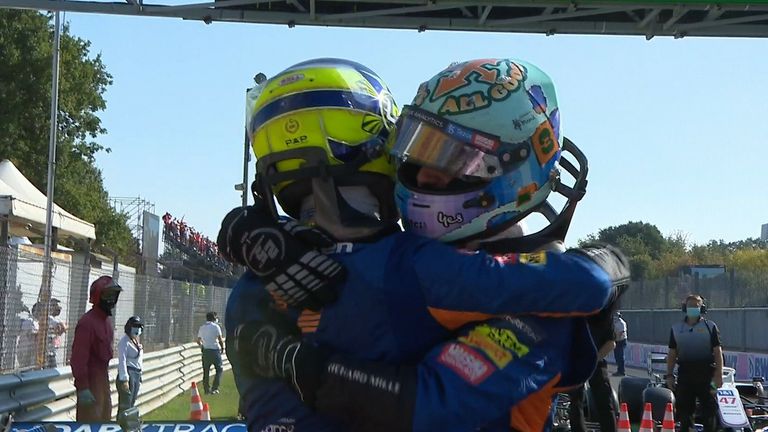“I walked in not understanding how bad it was…”
Those are the words of McLaren chief executive Zak Brown reflecting on his first weeks in the team at the end of 2016, following two painful seasons during which finishing races wasn’t a guarantee, let alone scoring points.
Under Brown’s leadership, with some significant help from team principal Andrea Stella, McLaren have transformed into a dominant force at the close of the current ground-effect regulations.
On Sunday, the team wrapped up the Constructors’ Championship with a record-equalling six rounds to go to match Red Bull’s 2023 feat of the earliest the teams’ title has ever been won.
Stella told Sky Sports F1: “It’s an incredible feeling, a feeling I want to share with the entire team. Congratulations to everyone at the factory, all our technical partners, everyone that supported us on this journey.
“Already last year, achieving the World Championship was incredible. Confirming this for the second year in a row is unbelievable.”
So, how have McLaren gone from struggling at the back to back-to-back champions….
Disaster with Dennis and Honda
When you think of McLaren pre-2017, the first individual that comes to mind is Ron Dennis, who was team principal between 1981 and 2009 before returning in 2014 as chief executive.
Some of F1’s all-time greats – including Niki Lauda, Alain Prost, Ayrton Senna, Mika Hakkinen and Lewis Hamilton – became world champion with McLaren under Dennis, who guided the team through different eras and regulations.
However, his last major decision took McLaren down a path which would take years to recover from – McLaren-Honda 2.0.
The original McLaren-Honda relationship from 1988 to 1992 was almost unstoppable as they won four consecutive drivers and constructors’ titles with Prost, Senna and Gerhard Berger.
A year after the start of F1’s turbo-hybrid era, McLaren and Honda were reunited from 2015 after Dennis championed the move, hoping to replicate the success of the late 1980s.
Dennis said: “[Honda’s engine progress] is mind-blowing, the engine is a piece of jewellery. They are further ahead than expected. The competitiveness of the engine is without question.”
The thinking was Honda would be the answer to beating the then dominant works Mercedes outfit. Instead, drivers Fernando Alonso and Jenson Button suffered several engine failures, were slow on the straights and even failed to make it to the start line on occasions.
It culminated in Alonso’s famous “GP2 engine” radio message after a young Max Verstappen in a Toro Rosso blasted past the McLaren on the main straight at Suzuka, Honda’s home race.
McLaren finished ninth in the Constructors’ Championship with just 27 points, their worst season since 1980, and although their performance improved in 2016, they were still a long way off the front-runners.
Brown told the New York Times: “When I started, we were losing more than £100m a year. I was sheltering the team, saying, ‘everything’s great’, but not everything was great. We were in big financial trouble.
“Right as we were turning the corner on track, and turning the corner financially off it, we got hit. Sponsorship stopped, prize money was significantly reduced. It almost put us out of business. We were a month or two away. We were that close.”
In September 2017, McLaren and Honda confirmed that year would be their last. Dennis had also ended his 37-year association with McLaren by selling his final shares after falling out with owner Mansour Ojjeh.
Now, with Renault engine power secured for the future, Brown was appointed McLaren Racing CEO in April 2018 and a new, fresh era began…
Upward trajectory but huge financial problems
A disappointing start to the season saw Eric Boullier resign as racing director in the summer of 2018 after four years in the role. Former Indycar champion Gil De Ferran and Andrea Stella split leadership responsibilities under Brown, with Stella effectively overseeing the trackside operations.
McLaren still had no official team principal but Brown has since revealed he offered Stella that opportunity.
“We actually kind of spoke about it. He felt he wasn’t ready at the time,” Brown said on the Beyond The Grid podcast. “He is very much a team player and I think he felt he wasn’t ready. So we didn’t promote him. He didn’t want to be promoted, but he then got a bigger role.
“And then even when promoted him this time around, when I called him, it wasn’t an immediate, yes, it was, ‘let me reflect. Let me reflect’.
“He’s very thoughtful, he thinks. And so even then it was like, ‘well, tell me more. And what do you think? When do you think I’d be good at it?’
“And he kind of looks in a mirror to see what do you think my strengths and weaknesses are? So I think he felt he wasn’t ready in 2018. I thought he probably was, but he certainly turned out to be ready now.”
McLaren finished sixth in the Constructors’ Championship with few signs of genuine progress. Alonso left to take a sabbatical from F1, while Stoffel Vandoorne was not given a new contract.
In came rookie Lando Norris and Carlos Sainz for 2019 along with new team principal Andreas Seidl, who had enjoyed huge success with Porsche in the World Endurance Championship.
Racing director Stella and new technical director James Key provided a fresh look for McLaren as they asserted themselves as best of the rest behind Mercedes, Ferrari and Red Bull.
Sainz scored the team’s first podium in nearly six years at the Brazilian Grand Prix and Norris claimed his maiden F1 podium in the season-opening 2020 Austrian Grand Prix, with the team clearly on an upward trajectory.
An outstanding performance from Pierre Gasly denied Sainz victory at Monza in the Covid-hit 2020 season but for the first time in the turbo-hybrid era, McLaren had a car which the drivers enjoyed and were tracking in the right direction.
However, off the track, McLaren were struggling financially due to the previous poor results and the impact of the pandemic.
Brown said: “[McLaren were] definitely on the brink – we were in a situation where we knew if we didn’t have a cash injection, we would have been at risk of starting the [next] year”
McLaren were saved by the sale of a 15 per cent stake in the team to New York investment group MSP Sports Capital for £185m at the end of 2020. The McLaren Group also sold their Technology Centre headquarters in Woking for £170m in a deal that would allow them to remain as a tenant there for 20 years.
F1 also introduced a budget cap from 2021 which levelled the playing field and particularly helped McLaren get back on terms with Mercedes, Ferrari and Red Bull, who were spending significantly more than the rest of the field and had pulled clear of the pack.
Landmark win followed by frustration
McLaren returned to Mercedes power in 2021 for the first time in seven years and Norris became the team’s leader with a breakthrough season.
Norris took podiums in Imola, Monaco and Austria on merit as he dominated against new team-mate Daniel Ricciardo, who struggled to get to grips with the McLaren car after joining from Renault.
But, Ricciardo was the driver to end McLaren’s nine-year winless run with a memorable Monza victory as he led home Norris in a one-two for the team.
Sky Sports F1‘s Martin Brundle said at the time: “In the 170 grands prix since their last victory in Brazil in 2012, they have been to hell and back, but by restructuring and regrouping they’ve pointed their considerable resource and talent in the right direction.”
New regulations in 2022 provided an opportunity for McLaren to leap into title contention but they went backwards, securing just one podium and falling from fourth to fifth in the Constructors’ Championship behind Alpine.
Brake issues and a general lack of performance led to a frustrating campaign, which Seidl described as a “new experience”.
Seidl told Brown during 2022 that he intended to leave McLaren at the end of 2026 to head up the developing Audi F1 project. Brown decided to fast-track the move by allowing Seidl to join Sauber early, so he could promote Stella to the role of team principal. A big move.
“Andrea obviously has a wealth of experience, not only with McLaren but a rich history with Ferrari,” Brown said after appointing Stella in December 2022.
“So it was someone that we knew, knew the team inside out, is a very hands-on person in the racing team. It was of high interest to me and the shareholders was to have someone leading the team that gets their hands dirty, so to speak.”
Stella’s impact and key technical change paves way for success
McLaren were way off at the start of 2023 and admitted they missed their winter targets, so were effectively not ready for the new season.
Stella quickly made changes as technical director Key parted ways with the team in March, while Peter Prodromou was promoted to head up aerodynamics, Neil Houldley given a lead role in engineering and design.
McLaren’s newfound sharpness in terms of recruitment was also highlighted by the poaching of Oscar Piastri from Alpine.
Brown snuck in to sign Piastri in an incredible saga that saw Alpine announce the rising star as their driver for 2023, before the Australian refuted the claim with his own social media post, and instead joined McLaren.
McLaren soon felt the impact of reshuffling their senior staff, while a strong rookie campaign from Piastri quickly justified the decision to replace Ricciardo.
Some new parts for the 2023 Austrian Grand Prix vaulted McLaren from fighting towards the rear of the field to challenging at the front behind Red Bull, with Norris taking a much-improved fourth at the Red Bull Ring, followed by second places at Silverstone and the Hungaroring.
While they were unable to pick up a grand prix victory, Norris and Piastri enjoyed double podiums in Japan and Qatar, with the Australian also taking a Sprint win in Doha as McLaren finished the season as Red Bull’s closest challengers.
McLaren then signed Rob Marshall – an engineer who worked closely with legendary designer Adrian Newey for 18 years – from Red Bull to lead the technical team.
Stella and Brown showed more ruthlessness as aerodynamic specialist David Sanchez, who had started around the same time as Marshall after joining from Ferrari, was moved on after just a few months with McLaren.
With Marshall given greater influence, McLaren were once more able to make major in-season gains in 2024. As things began to fall apart at Red Bull, Norris capitalised with a maiden win in Miami and was in a position to mount a title charge against Verstappen.
The failure of both Norris and the team to maximise the car’s stunning pace meant Verstappen was able to hold on for a fourth successive drivers’ championship, but perhaps more importantly for Brown and Stella, McLaren took the lead off Red Bull with seven rounds to go in the Constructors’ Championship and held off a late Ferrari surge to win the title for the first time in 20 years.
It was a testament to the incredible car the team had built and two youthful drivers who pushed each other forward with McLaren’s principles at the forefront of their minds too…
“The McLaren leadership of CEO Zak Brown and team principal Andrea Stella has worked extremely well,” said Brundle.
“Zak is the can-do, strongly commercially minded petrolhead and enthusiast, and Andrea is the calm pragmatic one with a longstanding technical background and is equally highly respected. Definitely yin and yang working in unison there.”
Strong McLaren culture tested
That success continued into 2025, with McLaren making a nonsense of pre-season predictions of a four-way title race by equalling the record for the earliest a team have sealed the Constructors’ Championship.
It should not be forgotten that many thought it would be impossible for a customer team to be front-runners in the early years of the turbo-hybrid era, but McLaren have proven that theory wrong with their Mercedes power unit.
In early 2023, there were fears Red Bull would dominate the remainder of the ground effect era until the new 2026 regulations, but McLaren have well and truly won the never-ending development war to assert themselves at the front of the grid.
One of Piastri or Norris will likely become McLaren’s first world champion since Hamilton in 2008, but despite each driver’s burning desire to claim what would be their maiden title, they continue to seemingly work in harmony.
The relationship has been tested at times, notably at the 2024 Hungarian Grand Prix where a remarkable team radio soap opera played out before Norris finally followed an order to let Piastri through for his maiden win.
Piastri perhaps breached the ‘Papaya Rules’ the drivers are held to when denting Norris’ title hopes by making an aggressive pass on his team-mate at the start of the Italian Grand Prix, but later in the season showed his willingness to be a team player when letting the Brit through to win the Sao Paulo GP Sprint. Norris would return the favour in Qatar after his title hopes had ended.
This year, the McLaren drivers have been free to race and aside from a clumsy mistake by Norris in Canada where he ran into the back of Piastri, and immediately took responsibility, both men have kept it pretty clean and delivered some stunning racing.
A recent stress test for relations came in Monza when Piastri was this time asked to let Norris through into second, and obliged after momentarily questioning the decision. Both drivers agreed after the race that they would continue to follow orders right up until the end of the season.
Even at the Singapore Grand Prix, where Norris made contact with Piastri, again potentially breaking McLaren’s racing conduct, on the opening lap, the Australian was furious on the radio but had already calmed down when speaking to the media, underlining that McLaren have created a culture to keep things behind closed doors.
This is quite different to the title battles we’ve seen play out between team-mates in the past. Even with Verstappen dominating Sergio Perez at Red Bull, tensions boiled over. Before that, Hamilton and Nico Rosberg almost went to war at Mercedes, while Piastri’s manager Mark Webber had his own controversies with Sebastian Vettel during Red Bull’s previous dominant spell.
The avoidance of such a situation developing at McLaren is largely down to the environment made by Brown and Stella, which clearly prioritises the team’s values over the drivers’ individual interests. Other team bosses have often talked up a similar approach, but it’s rarely been executed as successfully as in this instance.
While Brown has delivered on many fronts, Norris recently made it clear who he believes the most important figure has been in transforming the team..
“I do genuinely believe that Andrea is the most switched-on, humanly understanding, genuine person and the best team principal you can have,” Norris said.
“Ninety-nine per cent of the team is the same as we had three years prior. But it’s the person in charge, Andrea. It’s his ability to understand people, to put them together, to know how they work, how to get the most out of every single person. I think he has a better understanding of this than anyone I’ve ever met, even inside of racing, outside of racing. I think he’s one of the smartest people on that side of things.”
The saying goes that staying at the top is harder than getting there, and with a regulation change completely erasing their on-track advantage, the next question is whether Stella and Brown can oversee another era of greatness for McLaren…
F1’s title race now heads back to North America, with the United States Grand Prix in Austin up first on October 17-19 live on Sky Sports F1. Stream Sky Sports with NOW – no contract, cancel anytime

